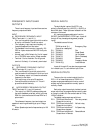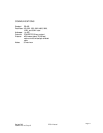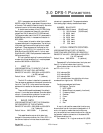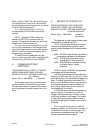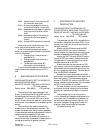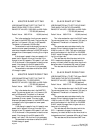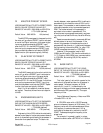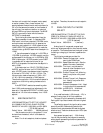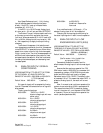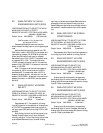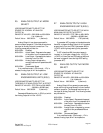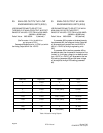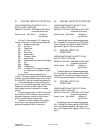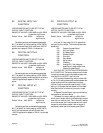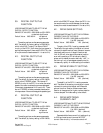Page 24
DFS-1 Manual Revised 7/95
POWERTEC Ind. Corp.©
are implied. Therefore, the maximum ratio setpoint
is 9.999.
17. ANALOG INPUT #1 MODE
SELECT
USE PARAMETER #17 TO SELECT THE PUR-
POSE OF A SIGNAL AT ANALOG INPUT #1.
RANGE OF VALUES: 0000 0000h to 0000 001Fh
0 TO 32 (decimal)
Default Value: 0000 0001h 1 (decimal)
Analog Input #1 is a general purpose input
which may be programmed for one of several modes
of operation. The mode affects how the signal is used
for setting or changing of the motor’s speed and/or
torque.
The following modes are provided for:
0000 0000h General Purpose Input - can be
read via the COMM port
0000 0001h Speed Reference input - Sets the
speed of the motor (see below)
0000 0002h Trim Input - may be used for
dancer or other transducer input
(not yet implemented)
0000 0003h External Torque Limit, Motoring -
Used in conjunction with param-
eter #5
0000 0004h External Torque Limit, Regenera-
tive - Used in conjunction with
parameter #5
0000 0005h External Horsepower Limit - Used
in conjunction with parameter #5
0000 0006h to 0000 001Fh Undefined -
Reserved for future use
If an undefined mode (...06h through ...1Fh) is
selected, Analog Input #1 will be inoperative.
The type of input is selected by parameter #18.
Each type of input has a lowest value and a highest
value.
The effective range of the input is set by param-
eters #19 and #20. Parameter #19 sets the low
threshold level and parameter #20 sets the highest
effective level. These two levels are set in EGU (see
parameter #14).
As a general purpose input ( ... 00h) Analog
input #1 may be used by the program to sense any
analog signal representing an external parameter for
use by the program.
the slave unit to match the line speed, motor speed,
or section (master). Many times, however, the
gearing between the slave motor and the surface of a
roll is not the same as the master, or the diameter of
the rolls vary from section to section, or motors of
different RPM’s may have to be tracked. The BASE
RATIO is a correction factor which allows the
SETPOINT to be adjusted.
The following are other examples of how the
Base Ratio parameter is used: if a standard 2500
RPM motor is to follow a standard 1750 RPM motor,
and both motors must attain their full speed at the
same time, and a setpoint of 1.0000 is desired, enter
1.4826 (2500/1750) into parameter #15 to make the
follower motor go 48.26% faster when the setpoint is
1.0000.
If the surface speed of a lead roll is 100 FPM at
1750 RPM (4-pole motor, 120 PPR encoder), and the
surface speed of the follower roll is 100FPM at 1550
RPM (4-pole motor, 120 PPR encoder), enter 0.8857
in parameter #15 to make the follower roll go
88.57% of the speed of the lead when the setpoint is
set to 1.0000.
If the lead motor is a 100 HP, 1750 RPM (8-pole,
240PPR), and the follower is a 5 HP, 3000 RPM (4-
pole, 120 PPR) motor, the reference output frequency
of the lead is 1750 x 240 *16 / 60 = 112 kHz. The
follower motor needs a frequency of 3000 x 120 *
16 / 60 = 96 kHz to operate at a 1.0000 setpoint.
Therefore the maximum 112 kHz must be reduced to
a maximum of 96 kHz by setting the base ratio to
0.8571.
If the SETPOINT needs to be something other
than 1.0000, make a proportional adjustment in the
base ratio. If the desired SETPOINT is 2.0000, use a
base ratio of 1/2 of the value necessary for a 1.0000
setpoint.
16. MAXIMUM RATIO
USE PARAMETER #16 TO SET THE HIGHEST
ALLOWABLE RATIO IN A SLAVE SYSTEM.
RANGE OF VALUES: 0000 0001h to 0001 869Fh
1 TO 99,999 (decimal)
Default Value: 0001 869Fh 99,999 (decimal)
Set the maximum ratio in the system if it is to
be lower than the default, which is the absolute
maximum.
Note: For all ratio setpoints, 4 decimal places



